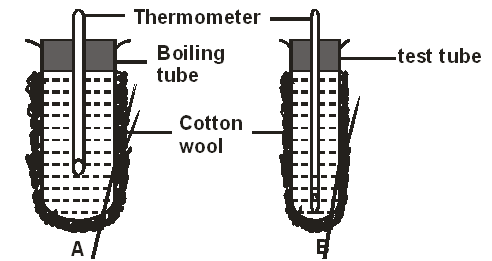SECTION A (40 MARKS)
Answer ALL the questions in the spaces provided
- The equation below represents a process that takes place in plants.
6CO2 + 6H2O → C6H12O6 + 6O2- Name the process. (1 mark)
- State two conditions necessary for the process to take place. (2 marks)
- State what happens to the end-products of the process. (5 marks)
- The diagram below represents a transverse section through a plant organ.
- From which plant organ was the section obtained? (1 mark)
- Give two reasons for your answer in (a) above. (2 marks)
- Name the parts labelled J, K and L. (3 marks)
- State two functions of the part labelled M. (2 marks)
- In a certain plant species which is normally green, a recessive gene for colour (n) causes the plant to be white in colour. Such plants die at an early age. In the heterozygous state, the plants are pale green in colour but grow to maturity.
- Give a reason for the early death of the plants with homozygous recessive gene. (2 marks)
- If a normal green plant was crossed with the pale green plant, what would be the genotype of the first filial generation (F1 generation)? Show your working. (4 marks)
- If heterozygous plants were self-pollinated and the resulting seeds planted, work out the population of their offspring that would grow to maturity. (2 marks)
-
- What is meant by the term biological control? (1 mark
-
- What is eutrophication? (3 marks)
- What are the effects of eutrophication? (3 marks)
- Name a substance that is responsible for acid rain. (1 mark)
-
- What is meant by the following terms
- Protandry? (1 mark)
- Self-sterility? (1 mark)
- The diagram below shows a stage during fertilization in a plant.

- Name the parts labeled Q, R and S. (3 marks)
- State two functions of the pollen tube. (2 marks)
- Label the Micropyle on the diagram. (1 mark)
- What is meant by the following terms
SECTION B (40 MARKS)
Answer question 6 (compulsory) and either question 7 or 8 in the spaces provided after Question 8
- In an experiment to investigate a certain physiological process, a boiling tube labelled A and a test-tube labelled B were covered with cotton wool. The two tubes were simultaneously filled with hot water and fitted with thermometer. The experiment set-up was as in the diagrams below.
Temperature readings were taken at the start and after every two minutes for twenty minutes.
The results were as shown below.
Time (minutes) Temperature (0C) Boiling tube A Test-Tube B 0 60 60 2 59 54 4 57 50 6 55 46 8 53 43 10 52 40 12 51 37 14 49 35 16 48 33 18 47 32 20 46 30 - Using the same axis, draw graphs of temperature against time. (6 marks)

-
- Work out the rate of heat loss in the boiling tube labelled A and test tube labelled B between the 5th and 15th (4 marks)
- Account for the answers in (b) (i) above. (2 marks)
- How does the explanation in (b) (ii) above apply to an elephant and a rat? (2 marks)
-
- State the role of the cotton wool in this experiment. (1 mark)
- Name two structures in mammals that play the role stated in (c) (i) above. (2 marks)
- State three advantages of having constant body temperature in mammals. (3 marks)
- Using the same axis, draw graphs of temperature against time. (6 marks)
-
- Explain how comparative embryology is an evidence for organic evolution. (2 marks)
- Describe the structure and functions of the various parts of the human ear. (18 marks)
-
- Describe the mechanism of gaseous exchange in a mammal. (16 marks)
- Explain the mechanism of stomata opening in plants. (4 marks)
Download BIOLOGY PAPER 2 - 2017 KITUI MOCK EXAMINATION.
Tap Here to Download for 50/-
Get on WhatsApp for 50/-
Why download?
- ✔ To read offline at any time.
- ✔ To Print at your convenience
- ✔ Share Easily with Friends / Students


